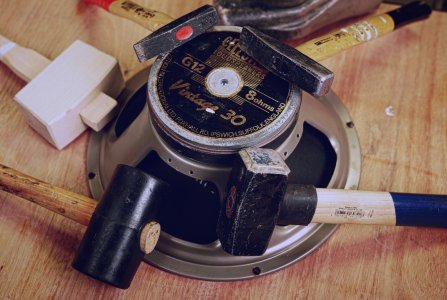headcrash
Roadie
- Messages
- 104
@The other John Browne : finally made it through all the V30 related videos you've been putting out for the last months or so (although I cowardly skipped many of the audio clips...).
I am really impressed with how much work you put into it and how you are trying to be neutral (where necessary ).
).
I also like your engineer's point of view.
Looking forward on your findings concerning speaker break-in.
I am an engineer, too. I mostly try to stay neutral or even skeptical, when people try to convince me of things, that I simply don't consider to be true, for example "put tube xy in your amp, and you will have way more bass" (apart from the fact that, what many don't know, we have a really short hearing memory, and we wouldn't be able to tell too many differences after a tube swap, but that's another story).
With that said, still, your videos teached me something AGAIN: A few years ago, I had a pair of Marshall G12 Vintage speakers and those two sounded significantly brighter in the upper treble (say 5 .. 6kHz region), than my old 1989 or 1990 blackframe V30 I had at the time, or the Mesa 2x12 cab in our practicing space, or the Harley Benton 4x12 Vintage there.
So my assumption was: the Marshall G12 Vintages ALWAYS sound brighter than standard Celestion V30s.... Unfortunately I have since sold all those speakers, so I can't verify this, or contribute anything more than what I have in my memory.
So obviously I cannot assume things to be true for every single specimen of round piece of paper glued to a voice coil, and that's being exposed to all kinds of environmental influence, when only one or two specimen of round piece of paper exhibits a certain behavior.
I am really impressed with how much work you put into it and how you are trying to be neutral (where necessary
I also like your engineer's point of view.
Looking forward on your findings concerning speaker break-in.
I am an engineer, too. I mostly try to stay neutral or even skeptical, when people try to convince me of things, that I simply don't consider to be true, for example "put tube xy in your amp, and you will have way more bass" (apart from the fact that, what many don't know, we have a really short hearing memory, and we wouldn't be able to tell too many differences after a tube swap, but that's another story).
With that said, still, your videos teached me something AGAIN: A few years ago, I had a pair of Marshall G12 Vintage speakers and those two sounded significantly brighter in the upper treble (say 5 .. 6kHz region), than my old 1989 or 1990 blackframe V30 I had at the time, or the Mesa 2x12 cab in our practicing space, or the Harley Benton 4x12 Vintage there.
So my assumption was: the Marshall G12 Vintages ALWAYS sound brighter than standard Celestion V30s.... Unfortunately I have since sold all those speakers, so I can't verify this, or contribute anything more than what I have in my memory.
So obviously I cannot assume things to be true for every single specimen of round piece of paper glued to a voice coil, and that's being exposed to all kinds of environmental influence, when only one or two specimen of round piece of paper exhibits a certain behavior.



